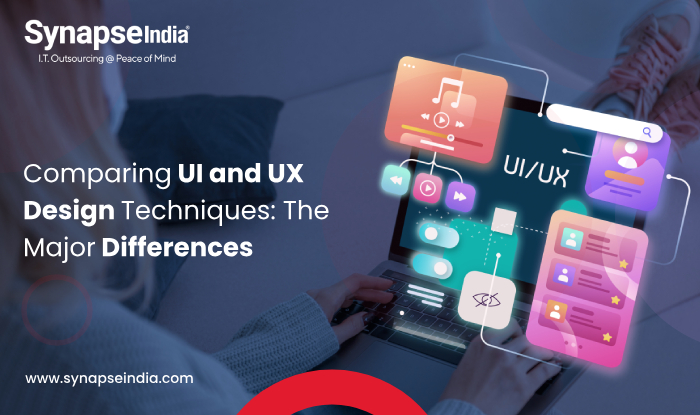Comparing UI and UX Design Techniques: The Major Differences
 19 Jan 2024
19 Jan 2024
“UI design is about making things look good on a website, using colors, fonts, and layouts while UX design is more about making sure the website works well for people.”

User Interface refers to the visual elements and design of a product that users interact with. It encompasses everything a user can interact with – buttons, icons, color schemes, typography, and more. On the other hand User Experience, is a broader concept that encompasses the overall interaction users have with a product. It goes beyond visuals and includes the entire user journey – from the initial interaction to the final satisfaction. UX design aims to create a seamless, efficient, and satisfying experience for users, whereas UI design focuses on creating a visually appealing and aesthetically pleasing interface that is intuitive and easy to navigate.
Key Differences Between UI and UX
- Focus: UI focuses on the visual elements and aesthetics, while UX is concerned with the holistic user journey and overall satisfaction.
- Components: UI includes design elements like colors and buttons, while UX includes research, usability testing, and user feedback.
- Goals: UI aims to create an attractive and visually appealing interface, while UX aims to provide a satisfying and efficient overall user experience.
While UX and UI design are related, they serve different purposes in the design and development of digital products. UI addresses the visual aspects, and UX ensures a positive and meaningful experience for users throughout their interaction with the product. Both are crucial for creating successful and user-friendly applications or websites.
A Detailed Comparison Between UI and UX
Here is a detailed comparison between UX and UI design that helps you to find out the major difference between UI and UX.
| Aspect | User Interface (UI) | User Experience (UX) |
| Definition | Focuses on the visual aspects of a product. | Encompasses the overall feel of the product. |
| Components | Involves design elements. | Includes the entire user journey. |
| Goal | Aims to create an aesthetically pleasing and visually appealing product. | Enhance overall satisfaction for efficient, and enjoyable user journey. |
| Focus Area | Primarily concerned with the look and feel of the product. | Concentrates on the holistic experience. |
| Metrics | Metrics may include usability, accessibility, and responsiveness. | Metrics involve user satisfaction, task success rates, and emotional responses. |
| Tools | Utilizes design tools like Sketch, Figma, and Adobe XD. | Incorporates research tools, prototyping software, and analytics tools. |
| Influence on UX | Contributes to UX. | Central to the overall UX. |
| Iterative Process | Involves iterative design processes. | Encompasses continuous iteration based on user feedback and analytics. |
| Example | The layout, colors, and buttons on a mobile app screen. | The overall satisfaction of a user completing a task on the app. |
User Interface and its types
User interface design is the point of interaction between users and digital devices or software applications. It encompasses the visual elements, controls, and design that users interact with when using a product.
Types of UI
1. Graphical User Interface (GUI):
- Description: GUI is the most common type of UI that uses graphical elements like icons, buttons, menus, and windows to facilitate user interactions.
- Example: The interface of operating systems like Windows, macOS, or Linux.
2. Command Line Interface (CLI):
- Description: CLI relies on text commands for user interaction. Users input commands to perform tasks, and the system responds with text-based outputs.
- Example: Command prompt or terminal in various operating systems.
3. Voice User Interface (VUI):
- Description: VUI allows users to interact with devices using spoken commands. Voice assistants like Siri, Alexa, or Google Assistant utilize VUI.
- Example: Amazon Echo, where users can ask questions or give commands verbally.
4. Touch User Interface:
- Description: TUI relies on touch gestures for interaction, commonly found in smartphones, tablets, and touchscreens.
- Example: Smartphone interfaces where users swipe, tap, or pinch to interact with the device.
5. Augmented Reality User Interface (ARUI):
- Description: ARUI overlays digital information onto the real-world environment, enhancing the user's perception.
- Example: AR applications like Pokémon GO, where virtual elements interact with the real world.
6. Virtual Reality User Interface (VRUI):
- Description: VRUI creates immersive environments where users can interact with digital elements in a virtual space.
- Example: VR gaming interfaces or virtual simulations.
Understanding these UI types and user interface design is essential for designing interfaces tailored to the specific needs and preferences of users and the context in which they interact with a product or system.
User Experience and its Types
User Experience (UX) encompasses the overall interaction and satisfaction users have with a product, system, or service. It focuses on providing a positive, efficient, and enjoyable experience throughout the user's journey.
Types of UX:
1. Visual Design:
- Description: Visual design in UX focuses on the aesthetics of a product, ensuring that the visual elements create a cohesive and pleasing interface.
- Importance: A visually appealing design enhances user engagement and contributes to a positive overall experience.
2. Information Architecture:
- Description: Information architecture involves organizing and structuring content to facilitate intuitive navigation and retrieval of information.
- Importance: Well-organized information architecture improves usability and helps users find what they need efficiently.
3. Interaction Design (IxD):
- Description: Interaction design focuses on designing interactive elements, ensuring that users can easily and effectively interact with the product.
- Importance: Well-designed interactions contribute to a seamless and user-friendly experience.
4. Usability
- Description: Usability assesses how easily users can achieve their goals within a product. It includes factors like efficiency, effectiveness, and satisfaction.
- Importance: High usability ensures that users can accomplish tasks with minimal effort and frustration.
5. Accessibility
- Description: Accessibility in UX ensures that the product is usable by individuals with diverse abilities, including those with disabilities.
- Importance: Prioritizing accessibility broadens the reach of the product and provides an inclusive user experience.
6. User Research:
- Description: User research involves understanding user needs, behaviors, and preferences through methods like interviews, surveys, and usability testing.
- Importance: Insights from user research inform design decisions, ensuring that the product meets user expectations.
Understanding these types of UX is essential for creating a comprehensive and effective user experience strategy. Each aspect plays a crucial role in ensuring that users have a positive, enjoyable, and meaningful interaction with the product.
UX and UI design play unique yet interconnected roles. Digital success arises not from the dominance of one over the other but from their collaborative integration. The art lies in understanding the types of each technique to create memorable and meaningful user experiences with UI and UX design companies. Striking this balance ensures that every interaction, from visual appeal to user satisfaction, contributes to the height of digital excellence.
Contact Us!
"From the Editor's Desk" is not just about the content. Our content writers will be sharing their thoughts on industry trends, new technologies, and emerging topics that are relevant to our readers. We believe that it's important to stay up-to-date with the latest news and trends, and We excited to share my thoughts and insights with you.
 19 Jan 2024
19 Jan 2024


 22 Jun 2016
22 Jun 2016
